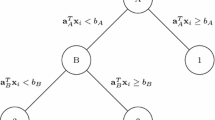Abstract
The computational cost, in both storage requirements and calculation, of performing an elimination ordering is considered as a function of the order in which the vertices of a graph are eliminated. Several different heuristic and relaxed heuristic algorithms for finding low cost elimination orderings are described and compared. The new heuristic and relaxed heuristic algorithms proposed in this paper are shown to find computationally more efficient elimination orderings than previously proposed heuristic algorithms.
Similar content being viewed by others
References
Andersen, S. K., Olesen, K. G., Jensen, F. V. and Jensen, F. (1989) HUGIN—A shell for building Bayesian belief universes for expert systems. Proceedings of the Eleventh International Joint Conference on Artificial Intelligence, pp. 1080–5.
Arnborg, S., Corneil, D. G. and Proskurowski, A. (1987) Complexity of finding embeddings in a k-tree. SIAM Journal of Algebra and Discrete Methods, 8, 277–84.
Cannings, C., Thompson, E. A. and Skolnick, M. H. (1978) Probability functions on complex pedigrees. Advances in Applied Probability, 10, 26–61.
Harbron, C. G. (1994) A pedigree based algorithm for generating peeling sequences. Submitted to I M A Journal of Mathematics Applied in Medicine and Biology.
Hasstedt, S. E. and Cartwright, P. E. (1981) PAP: Pedigree analysis package. Technical Report 13, Department of Medical Biophysics and Computing, University of Utah, Salt Lake City, 1981.
Kjaerrullf, U. (1992) Optimal decomposition of probabilistic networks by simulated annealing. Statistics and Computing, 2, 7–17.
Kjaerullf, U. (1990) Triangulation of graphs—algorithms giving small total state space. Technical Report R 90–09, University of Aalborg, Denmark.
Lange, K., Boehnke, M. and Weeks, D. (1985) Programs for pedigree analysis. Technical Report, Dept. of Biomathematics, University of California, Los Angeles.
Lathrop, G. M. and Lalouel, J. M. (1984) Easy calculations of lod scores and genetic risks on small computers. American Journal of Human Genetics, 36, 460–5.
Lauritzen, S. L. and Spiegelhalter, D. J. (1988) Local computations with probabilities on graphical structures and their application to expert systems. Journal of the Royal Statistical Society, Series B, 50, 157–224.
Lewis, H. E. (1963) The Tristan islanders: a medical study of isolation. New Scientist, 20, 720–2.
Olesen, K. G., Kjaerulff, U., Jensen, F., Jensen, F. V., Falck, B., Andreassen, S. and Anderson, S. K. (1989) A MUNIN network for the median nerve—a case study on loops. Applied Artificial Intelligence, 3, 301–19.
Rose, D. J. (1970) Triangulated graphs and the elimination process. Journal of Mathematical Analysis and Applications, 32, 597–609.
Rose, D. J. (1972) A graph-theoretic study of the numerical solution of sparse positive definite systems of linear equations. In Graph Theory and Computing, R. Read (ed). pp. 183–217. Academic Press, New York.
Thomas, A. (1993) Sumo: A program for calculations on finite state Markov graphs. Statistics Research Report, 93:05, School of Mathematical Sciences, University of Bath, Bath BA2 7AY, UK.
Thomas, A. (1986) Optimal computation of probability functions for pedigree analysis. I M A Journal of Mathematics Applied in Medicine and Biology, 3, 167–178.
Thomas, A. (1991) Pedpack 3.0. Manual. School of Mathematica Sciences, University of Bath, Bath BA2 7AY, UK.
Author information
Authors and Affiliations
Rights and permissions
About this article
Cite this article
Harbron, C. Heuristic algorithms for finding inexpensive elimination schemes. Stat Comput 5, 275–287 (1995). https://doi.org/10.1007/BF00162500
Issue Date:
DOI: https://doi.org/10.1007/BF00162500




